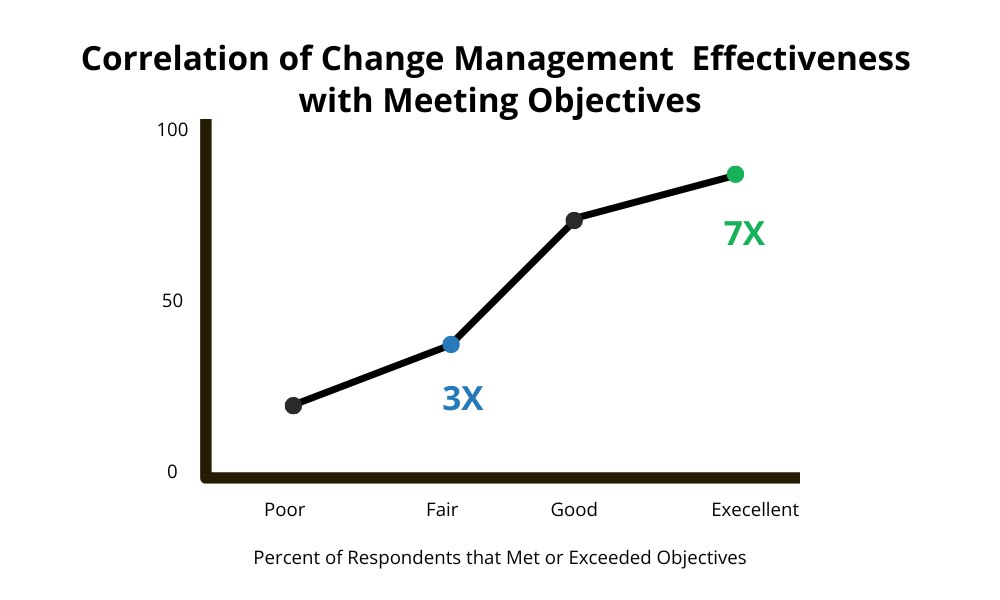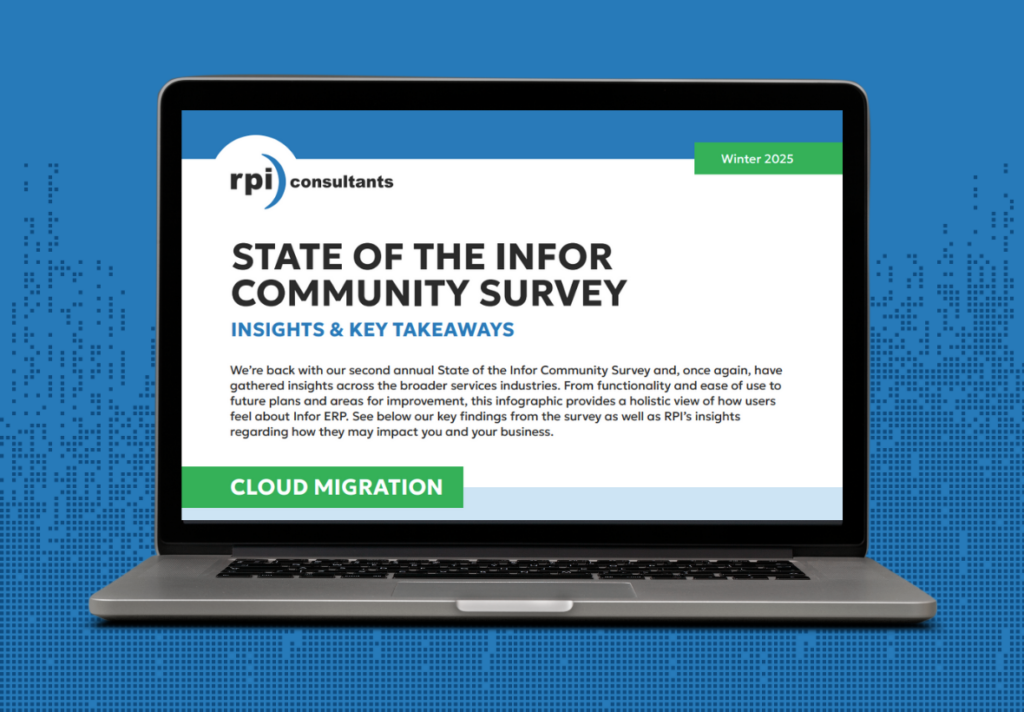It’s true that a CloudSuite implementation is an IT-based project—but beyond the technical aspects and requirements of migrating to a cloud-based ERP, it’s also a people project.
With that in mind, organizations looking to reap the many benefits of moving to CloudSuite, including cost savings, increased security, and greater process efficiency, must anticipate and address the human factors that drive success.
The scope and volume of the changes brought about by an ERP migration or implementation can be overwhelming, but adaptation and adoption by your user base is critical to maximizing the rewards of your move to the cloud.
This is why ensuring that your stakeholders are an asset to your technology project, not an impediment, requires prioritizing change management.
So, what exactly is change management? Below we discuss the nuances associated with it, why it’s important, how to prioritize it, and why leveraging expert support can ensure greater success with cloud-based ERP implementations.
What is Change Management?
The Harvard Business School defines change management as “the process of guiding organizational change to fruition, from the earliest stages of conception and preparation, through implementation and, finally, to resolution. An effective management strategy is crucial to ensure businesses successfully transition and adapt to any changes that may occur.”
In other words, change management focuses on the people who are impacted by changes to the application(s) they use and, often, to the associated business processes to guide them through a smooth transition from current state to the future state.
While change management may seem like a nicety rather than a necessity during an ERP implementation, research in this field shows us that technology projects that impact employees are most successful when they fully consider the factors on both the technical and the people sides that determine the project outcomes.
According to Prosci benchmarking data, organizations that prioritize change management are seven times more likely to meet or exceed their project objectives.

After all, your business operations depend upon your people, processes, and technology—each part of that trifecta plays an important role in getting the most out of your ERP solution.
Getting Started with ERP Change Management
If you’re considering implementing CloudSuite, or another cloud-based ERP, a great place to start change management is with Prosci’s 4 P’s exercise:
- Project: We start off with the easiest one—what is this project? Give your project a descriptive name and a concise, straightforward definition.
- Purpose: What is your “why?” The motivation for the organization to do this project in the first place? The purpose is your project’s North Star and includes specific goals, intended outcomes, and the benefits you hope to realize.
- Particulars: What do you know at this early stage about what will be changing? Will this project mark a leap forward in automation? Are you planning to redesign your financial structures? Write down the major changes that the organization will experience between current and future states.
- People: The impacted parties won’t fully come into focus until the engagement is underway and system design begins to take shape, but you can and should identify the major stakeholder populations that any significant change to your ERP will affect ahead of time.
Articulating the project fundamentals this way helps create context for the project and for the way change management will be integrated into the implementation.
It will also facilitate alignment of priorities and overarching business objectives, which will help steer levels of change before, during, and post project engagement.
ERP Change Management is People-Focused
Whether or not organizations have existing change management knowledge or are intentionally employing change management practices for their technology projects, most leaders understand the importance of good communication and effective training.
These activities are pillars of RPI’s change management approach. After all, no one likes to feel uninformed or unprepared for changes that may impact them directly.
Let’s explore further why these two topics are so integral to supporting your stakeholders through an ERP implementation:
- Communication: “Communication is the lifeline of any relationship” and it couldn’t be any truer when it comes to a cloud-based ERP implementation. Take time to ensure that all stakeholders are caught up on what is going to be changing, the timeline for it, how it will impact current business processes, and the value it’s going to bring to the organization. Be sure to also include regular touchpoints to communicate progress and blockers, as well as any milestone achievements. Three key principles to adhere to for all project communications are clarity, timeliness, and honesty.
- Training: If you’re migrating to CloudSuite, or another cloud-based ERP, you’re going to want to provide your super users and subject matter experts with as many training opportunities as possible. Familiarizing business users with new processes frequently will diminish any fears associated with change. The earlier you can get your user base acquainted with new system(s), the better. Not to mention, frequent training encourages user-adoption, helps with fostering career development, and ultimately builds trust with leadership.
Preparing for Change Resistance
Aversion to change is a part of human nature, so it’s both understandable and expected for folks to have reservations about new processes and technology.
While executives may be able to clearly understand the “big picture” value of the implementation, it’s the core business users who experience the most direct impacts and whose buy-in needs to be secured.
Leadership and managers should be prepared to answer the following questions from business users:
- Why are we doing this?
- What’s in it for me?
- What kind of training am I going to need and when will I receive it?
- How is this going to affect my day-to-day life?
These questions and more are in the minds of many users and should be welcomed as a form of stakeholder engagement. The way you answer these questions will influence the organization’s perception of the project and can proactively quell resistance.
Open communication also creates a stronger sense of trust in leadership and greater employee satisfaction, and ultimately a higher ERP implementation ROI.
Developing a Change Management Strategy
Accounting for change resistance, proper training, and communication, are core components to an overarching change management strategy, but there is more that needs to be done, including:
Resourcing: Determine what roles you will need to support your change management strategy, who will fill them, and what their responsibilities to the project will be in this capacity. Project sponsors are the best spokespeople for messaging about the overall vision and organization-wide impacts. Managers and supervisors are trusted by their employees and consequently are the best source of information whenever departmental or individual changes are concerned.
Additionally, consider enlisting “change champions” from outside the project team to facilitate user-adoption and long-term implementation success. These individuals will be early adopters who build enthusiasm, provide feedback, and identify sources of resistance.
Also make note of your internal capabilities, as there may be change management experience and expertise among your organization’s change managers. And marketing and communications personnel can often be of great assistance in executing change management activities. Consultants can help fill any internal gaps you may have in these areas.
Project identity & branding: Engaging in a Cloud-based implementation is a massive undertaking for many areas of your business. Consider documenting details such as the name of the project and how it will be communicated across internal teams as well as any external stakeholders.
It’s in the organization’s best interest to explain the changes in a positive light, so give special attention to how you will brand the project.
Impact assessment: Once your subject matter experts and business process owners have a firm understanding of the new system design, it’s time to catalog and evaluate the most impactful changes that your organization will experience.
It’s important to take the time to document significant changes, identify who will be impacted and how, the benefits associated with that change, and determine what, if any, action plan will benefit your impacted stakeholders as they adjust.
Handling Change Management Effectively
At the end of the day, ERP solutions support business processes that largely rely on people. These projects, if not handled responsibly, can result in burnout, turnover, and other unfavorable side effects.
It’s this inherent risk that makes managing organizational change for a CloudSuite implementation, or any other cloud-based ERP, a high-stakes proposition. Whether it’s a migration or net-new implementation, change management touches many business functions associated with a cloud-based ERP implementation.
As Neville Turbet famously said, “The single biggest failure point for ERP implementations is the need for change management.” It follows then that with the proper change management, anything is possible.
Best practices for managing change encourage calling in additional support. If your business needs assistance with change management, consider partnering with an industry-leader like RPI Consultants.
We can help you evaluate your organization’s change readiness and risks. As part of our CloudSuite pre-planning process, we can also help you define goals, document milestones, identify available resources, and everything else necessary for ensuring a successful CloudSuite implementation.
At RPI, we believe relationship building is the foundation upon which all business is conducted. Our team is an extension of your team, and we firmly believe that our combined success stems from the quality of our working relationships.



